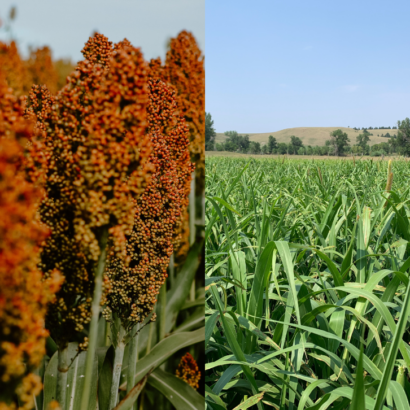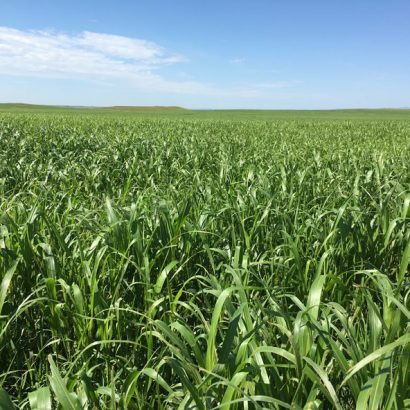It’s that time of year again – the days are already getting shorter and the nights a little cooler. Even though for most of us in agriculture it probably feels like spring never really ended, fall is now just around the corner. It never fails, there’s always a handful of days in the Upper Midwest during early fall when different areas receive their first hard frost of the year and producers have questions about management of annual forages during this time.
Here’s a breakdown of the various scenarios:
Species
While there are many species that can present nutritional concerns under certain conditions, this fall timeframe is when two main categories of species are the primary talking points:
- Millets
- Sorghums, Sudangrasses, and hybrids of sorghums/sudangrasses

Prussic Acid
Prussic acid, otherwise known as Hydrocyanic acid (cyanide), is a compound released when the cells of certain plants burst under stressful conditions. These conditions usually correlate with plant damage or very rapid new plant growth.
Prussic acid can reach toxic levels in Sorghum, Sorghum x Sudangrass, or Sudangrass. It can occur in a few other wild or weedy species, but these three categories are the only planted forage crops that are widely-used and need special management. Millets do not contain toxic levels of prussic acid and no millet species need to be considered for special management due to prussic acid at any growth stage.
There are two main periods during the growth of Sorghum, Sorghum x Sudangrass, or Sudangrass in which prussic acid management should be considered:
After a Frost: This is why special management is vital for these species during the fall season. The freezing of the plant causes cell walls to burst, releasing the prussic acid and causing potentially toxic levels in the forage for a period of time.
Grazing Management
- Avoid grazing during the period when your first hard frost of the year is likely to occur. If you are actively grazing and a frost event occurs, remove livestock from the crop for about one week.
- One week after a killing frost, the plants will be drying down in the field and are once again safe to graze. Many producers choose to delay grazing until a week after the killing frost so that prussic acid concerns are eliminated altogether.
Harvest Management
- For any mechanical harvest of these forages, there is minimal concern with prussic acid.
- Prussic acid will dissipate from the plant during the curing process for dry hay.
- Prussic acid will also dissipate during the fermentation process for silage.
- This leaves no necessary management considerations due to prussic acid if taking these crops as harvested feed.
New Growth: Young, new growth of these species can be higher in prussic acid concentrations while older plant material tends to become more diluted.
Grazing Management
- Delay grazing of these species until plants have reached 18-24 inches in height.
- Do not graze new tillers that regrow after mechanical harvest or a light frost that does not kill the entire plant until new growth has reached 18-24 inches in height or been killed by a frost and allowed to cure for one week.
Harvest Management
- By the time new growth has reached a point where most producers would consider going to the expense of mechanically harvesting the forage, it has enough growth to be considered safe from prussic acid.
- Even if very young growth was cut for hay or silage, the curing or fermentation processes would allow prussic acid to dissipate to safe levels.
Nitrates
Nitrate poisoning can occur in livestock if nitrate levels in primary forage sources are elevated. Many species, including several common forage crops, can accumulate high levels of nitrates under stress conditions that stunt growth. In forages such as sorghums or millets, if there is adequate to excessive soil nitrogen, but the plant is stunted and unable to convert nitrates into plant protein, then nitrates will accumulate in the forage, starting in the lower portions of the plant. This can be caused by various conditions such as drought, hail, frost, or any conditions that do not kill the plant but prevent normal and healthy growth.
Grazing Management
- Avoid grazing drought-stressed forages until they have had a chance to recover.
- Avoid grazing for several days after a rainfall event that causes drought-stressed plants to actively grow again as nitrate levels will likely be elevated during the initial period of new growth.
- Avoid grazing after a light frost that does not kill the plant as the plant will continue to take up nitrates from the soil, but frost damage will cause nitrates to accumulate for a period of time.
- If drought conditions or a killing frost cause the plants to die and no more growth will occur, testing the forage for nitrates prior to grazing is recommended.
- Supplementing with low-nitrate forages while grazing high-nitrate forages can help reduce some of the potential for nitrate poisoning.
Harvest Management
Hay
- The curing process for dry hay will not reduce nitrates to safe levels on its own.
- If forage is cut during a period when nitrate levels are in question, test hay prior to feeding.
- High-nitrate hay can be blended and fed with lower nitrate feed to salvage some value if tests come back above thresholds for the intended class of livestock.
Silage
- The fermentation process in producing silage will, in many cases, reduce nitrates to safe levels for livestock.
- In silage that was high risk for nitrates when it was harvested, it is always best to test prior to feeding. If proper fermentation has occurred, the risk of toxic levels of nitrates is relatively low.
The moral of this story is that although there are valid nutritional concerns, the risks do not outweigh the production potential of these popular forage crops. There are relatively simple steps in management that can be taken to reduce or eliminate issues from prussic acid and nitrates.
As always, we’re here to help with any unanswered questions – contact one of our Forage + Cover Crop Specialists with any questions. Wishing everyone a safe and successful fall season!




Discussion
0 Comments